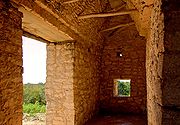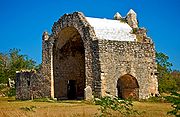
Dzibilchaltun
Encyclopedia





Maya civilization
The Maya is a Mesoamerican civilization, noted for the only known fully developed written language of the pre-Columbian Americas, as well as for its art, architecture, and mathematical and astronomical systems. Initially established during the Pre-Classic period The Maya is a Mesoamerican...
archaeological site
Archaeological site
An archaeological site is a place in which evidence of past activity is preserved , and which has been, or may be, investigated using the discipline of archaeology and represents a part of the archaeological record.Beyond this, the definition and geographical extent of a 'site' can vary widely,...
in the Mexican state
States of Mexico
The United Mexican States is a federal republic formed by 32 federal entities .According to the Constitution of 1917, the states of the federation are free and sovereign. Each state has their own congress and constitution, while the Federal District has only limited autonomy with a local Congress...
of Yucatán
Yucatán
Yucatán officially Estado Libre y Soberano de Yucatán is one of the 31 states which, with the Federal District, comprise the 32 Federal Entities of Mexico. It is divided in 106 municipalities and its capital city is Mérida....
, approximately 10 miles north of state capital Mérida
Mérida, Yucatán
Mérida is the capital and largest city of the Mexican state of Yucatán and the Yucatán Peninsula. It is located in the northwest part of the state, about from the Gulf of Mexico coast...
.
Overview
The site has been continuously occupied for thousands of years, although it has expanded and contracted from mid-sized city to small town more than once in its long history. It is about 30 minutes from MeridaMerida
Places of the world named Mérida or Merida include:*Mérida, Spain, capital city of the Spanish Community of Extremadura*Mérida, Yucatán, capital city of the Mexican state of Yucatán*Merida, Leyte, a municipality in Leyte province in the Philippines...
and the famous sea that supposedly was the site of impact of the meteorite that killed the dinosaurs.
Architecture
The most famous structure is the Temple Of The Seven Dolls, so named because of seven small effigiesEffigy
An effigy is a representation of a person, especially in the form of sculpture or some other three-dimensional form.The term is usually associated with full-length figures of a deceased person depicted in stone or wood on church monuments. These most often lie supine with hands together in prayer,...
found at the site when the temple was discovered under the ruins of a later temple pyramid by archaeologists in the 1950s. On the Spring equinox
Equinox
An equinox occurs twice a year, when the tilt of the Earth's axis is inclined neither away from nor towards the Sun, the center of the Sun being in the same plane as the Earth's equator...
, the sun rises so that it shines directly through one window of the temple and out the other. This is a similar event to the descending snake of Chichen Itza designed to show the power of the gods. The temple is connected to the rest of the site by a sacbe
Sacbe
right|thumb|Sacbe at Dzibilchaltun in the Yucatánthumb|right|Arch at the end of the sacbé, Kabah, YucatánSacbe, plural Sacbeob, or "white ways" are raised paved roads built by the Maya civilization of pre-Columbian Mesoamerica...
, or "white road," so-called because they were originally coated with white limestone, built over stone-and-rubble fill.
Surroundings
The other major feature of Dzibilchaltún is its cenoteCenote
A cenote is a deep natural pit, or sinkhole, characteristic of Mexico and Central America, resulting from the collapse of limestone bedrock that exposes groundwater underneath...
, which is used as a swimming hole by local residents year round. Dzibilchaltún also contains the ruin of a 16th century Spanish church built at the site after the conquest.
The archaeological site contains a museum which houses Maya artifacts from the site and the adjacent region.

